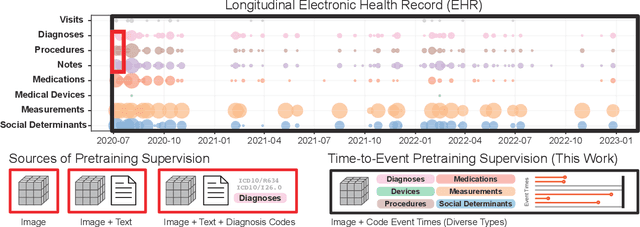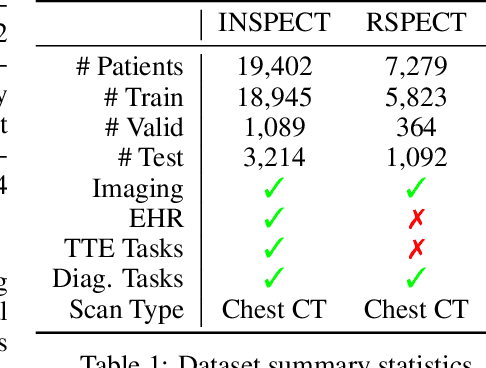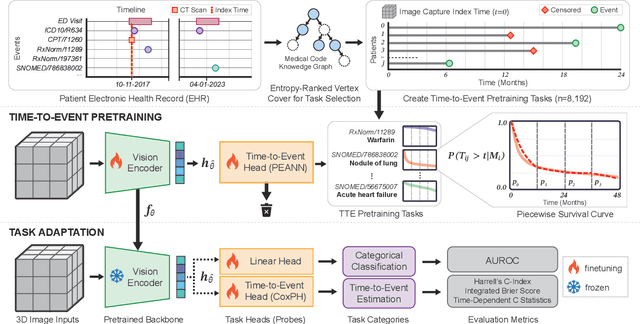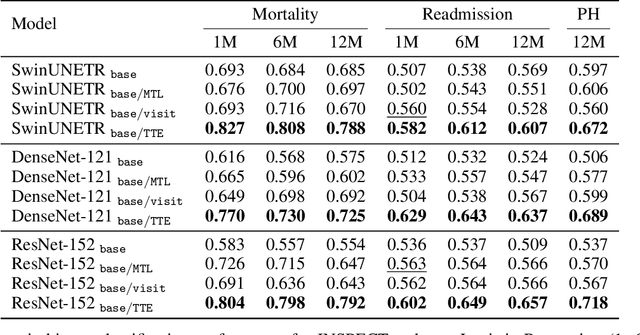Alejandro Lozano
MicroVQA: A Multimodal Reasoning Benchmark for Microscopy-Based Scientific Research
Mar 17, 2025Abstract:Scientific research demands sophisticated reasoning over multimodal data, a challenge especially prevalent in biology. Despite recent advances in multimodal large language models (MLLMs) for AI-assisted research, existing multimodal reasoning benchmarks only target up to college-level difficulty, while research-level benchmarks emphasize lower-level perception, falling short of the complex multimodal reasoning needed for scientific discovery. To bridge this gap, we introduce MicroVQA, a visual-question answering (VQA) benchmark designed to assess three reasoning capabilities vital in research workflows: expert image understanding, hypothesis generation, and experiment proposal. MicroVQA consists of 1,042 multiple-choice questions (MCQs) curated by biology experts across diverse microscopy modalities, ensuring VQA samples represent real scientific practice. In constructing the benchmark, we find that standard MCQ generation methods induce language shortcuts, motivating a new two-stage pipeline: an optimized LLM prompt structures question-answer pairs into MCQs; then, an agent-based `RefineBot' updates them to remove shortcuts. Benchmarking on state-of-the-art MLLMs reveal a peak performance of 53\%; models with smaller LLMs only slightly underperform top models, suggesting that language-based reasoning is less challenging than multimodal reasoning; and tuning with scientific articles enhances performance. Expert analysis of chain-of-thought responses shows that perception errors are the most frequent, followed by knowledge errors and then overgeneralization errors. These insights highlight the challenges in multimodal scientific reasoning, showing MicroVQA is a valuable resource advancing AI-driven biomedical research. MicroVQA is available at https://huggingface.co/datasets/jmhb/microvqa, and project page at https://jmhb0.github.io/microvqa.
Video Action Differencing
Mar 10, 2025Abstract:How do two individuals differ when performing the same action? In this work, we introduce Video Action Differencing (VidDiff), the novel task of identifying subtle differences between videos of the same action, which has many applications, such as coaching and skill learning. To enable development on this new task, we first create VidDiffBench, a benchmark dataset containing 549 video pairs, with human annotations of 4,469 fine-grained action differences and 2,075 localization timestamps indicating where these differences occur. Our experiments demonstrate that VidDiffBench poses a significant challenge for state-of-the-art large multimodal models (LMMs), such as GPT-4o and Qwen2-VL. By analyzing failure cases of LMMs on VidDiffBench, we highlight two key challenges for this task: localizing relevant sub-actions over two videos and fine-grained frame comparison. To overcome these, we propose the VidDiff method, an agentic workflow that breaks the task into three stages: action difference proposal, keyframe localization, and frame differencing, each stage utilizing specialized foundation models. To encourage future research in this new task, we release the benchmark at https://huggingface.co/datasets/jmhb/VidDiffBench and code at http://jmhb0.github.io/viddiff.
BIOMEDICA: An Open Biomedical Image-Caption Archive, Dataset, and Vision-Language Models Derived from Scientific Literature
Jan 14, 2025Abstract:The development of vision-language models (VLMs) is driven by large-scale and diverse multimodal datasets. However, progress toward generalist biomedical VLMs is limited by the lack of annotated, publicly accessible datasets across biology and medicine. Existing efforts are restricted to narrow domains, missing the full diversity of biomedical knowledge encoded in scientific literature. To address this gap, we introduce BIOMEDICA, a scalable, open-source framework to extract, annotate, and serialize the entirety of the PubMed Central Open Access subset into an easy-to-use, publicly accessible dataset. Our framework produces a comprehensive archive with over 24 million unique image-text pairs from over 6 million articles. Metadata and expert-guided annotations are also provided. We demonstrate the utility and accessibility of our resource by releasing BMCA-CLIP, a suite of CLIP-style models continuously pre-trained on the BIOMEDICA dataset via streaming, eliminating the need to download 27 TB of data locally. On average, our models achieve state-of-the-art performance across 40 tasks - spanning pathology, radiology, ophthalmology, dermatology, surgery, molecular biology, parasitology, and cell biology - excelling in zero-shot classification with a 6.56% average improvement (as high as 29.8% and 17.5% in dermatology and ophthalmology, respectively), and stronger image-text retrieval, all while using 10x less compute. To foster reproducibility and collaboration, we release our codebase and dataset for the broader research community.
Automated Generation of Challenging Multiple-Choice Questions for Vision Language Model Evaluation
Jan 06, 2025



Abstract:The rapid development of vision language models (VLMs) demands rigorous and reliable evaluation. However, current visual question answering (VQA) benchmarks often depend on open-ended questions, making accurate evaluation difficult due to the variability in natural language responses. To address this, we introduce AutoConverter, an agentic framework that automatically converts these open-ended questions into multiple-choice format, enabling objective evaluation while reducing the costly question creation process. Our experiments demonstrate that AutoConverter can generate correct and challenging multiple-choice questions, with VLMs demonstrating consistently similar or lower accuracy on these questions compared to human-created ones. Using AutoConverter, we construct VMCBench, a benchmark created by transforming 20 existing VQA datasets into a unified multiple-choice format, totaling 9,018 questions. We comprehensively evaluate 33 state-of-the-art VLMs on VMCBench, setting a new standard for scalable, consistent, and reproducible VLM evaluation.
Time-to-Event Pretraining for 3D Medical Imaging
Nov 14, 2024



Abstract:With the rise of medical foundation models and the growing availability of imaging data, scalable pretraining techniques offer a promising way to identify imaging biomarkers predictive of future disease risk. While current self-supervised methods for 3D medical imaging models capture local structural features like organ morphology, they fail to link pixel biomarkers with long-term health outcomes due to a missing context problem. Current approaches lack the temporal context necessary to identify biomarkers correlated with disease progression, as they rely on supervision derived only from images and concurrent text descriptions. To address this, we introduce time-to-event pretraining, a pretraining framework for 3D medical imaging models that leverages large-scale temporal supervision from paired, longitudinal electronic health records (EHRs). Using a dataset of 18,945 CT scans (4.2 million 2D images) and time-to-event distributions across thousands of EHR-derived tasks, our method improves outcome prediction, achieving an average AUROC increase of 23.7% and a 29.4% gain in Harrell's C-index across 8 benchmark tasks. Importantly, these gains are achieved without sacrificing diagnostic classification performance. This study lays the foundation for integrating longitudinal EHR and 3D imaging data to advance clinical risk prediction.
μ-Bench: A Vision-Language Benchmark for Microscopy Understanding
Jul 01, 2024



Abstract:Recent advances in microscopy have enabled the rapid generation of terabytes of image data in cell biology and biomedical research. Vision-language models (VLMs) offer a promising solution for large-scale biological image analysis, enhancing researchers' efficiency, identifying new image biomarkers, and accelerating hypothesis generation and scientific discovery. However, there is a lack of standardized, diverse, and large-scale vision-language benchmarks to evaluate VLMs' perception and cognition capabilities in biological image understanding. To address this gap, we introduce {\mu}-Bench, an expert-curated benchmark encompassing 22 biomedical tasks across various scientific disciplines (biology, pathology), microscopy modalities (electron, fluorescence, light), scales (subcellular, cellular, tissue), and organisms in both normal and abnormal states. We evaluate state-of-the-art biomedical, pathology, and general VLMs on {\mu}-Bench and find that: i) current models struggle on all categories, even for basic tasks such as distinguishing microscopy modalities; ii) current specialist models fine-tuned on biomedical data often perform worse than generalist models; iii) fine-tuning in specific microscopy domains can cause catastrophic forgetting, eroding prior biomedical knowledge encoded in their base model. iv) weight interpolation between fine-tuned and pre-trained models offers one solution to forgetting and improves general performance across biomedical tasks. We release {\mu}-Bench under a permissive license to accelerate the research and development of microscopy foundation models.
Recent Advances, Applications, and Open Challenges in Machine Learning for Health: Reflections from Research Roundtables at ML4H 2023 Symposium
Mar 03, 2024Abstract:The third ML4H symposium was held in person on December 10, 2023, in New Orleans, Louisiana, USA. The symposium included research roundtable sessions to foster discussions between participants and senior researchers on timely and relevant topics for the \ac{ML4H} community. Encouraged by the successful virtual roundtables in the previous year, we organized eleven in-person roundtables and four virtual roundtables at ML4H 2022. The organization of the research roundtables at the conference involved 17 Senior Chairs and 19 Junior Chairs across 11 tables. Each roundtable session included invited senior chairs (with substantial experience in the field), junior chairs (responsible for facilitating the discussion), and attendees from diverse backgrounds with interest in the session's topic. Herein we detail the organization process and compile takeaways from these roundtable discussions, including recent advances, applications, and open challenges for each topic. We conclude with a summary and lessons learned across all roundtables. This document serves as a comprehensive review paper, summarizing the recent advancements in machine learning for healthcare as contributed by foremost researchers in the field.
Zero-Shot Clinical Trial Patient Matching with LLMs
Feb 05, 2024Abstract:Matching patients to clinical trials is a key unsolved challenge in bringing new drugs to market. Today, identifying patients who meet a trial's eligibility criteria is highly manual, taking up to 1 hour per patient. Automated screening is challenging, however, as it requires understanding unstructured clinical text. Large language models (LLMs) offer a promising solution. In this work, we explore their application to trial matching. First, we design an LLM-based system which, given a patient's medical history as unstructured clinical text, evaluates whether that patient meets a set of inclusion criteria (also specified as free text). Our zero-shot system achieves state-of-the-art scores on the n2c2 2018 cohort selection benchmark. Second, we improve the data and cost efficiency of our method by identifying a prompting strategy which matches patients an order of magnitude faster and more cheaply than the status quo, and develop a two-stage retrieval pipeline that reduces the number of tokens processed by up to a third while retaining high performance. Third, we evaluate the interpretability of our system by having clinicians evaluate the natural language justifications generated by the LLM for each eligibility decision, and show that it can output coherent explanations for 97% of its correct decisions and 75% of its incorrect ones. Our results establish the feasibility of using LLMs to accelerate clinical trial operations.
Open World Object Detection in the Era of Foundation Models
Dec 10, 2023Abstract:Object detection is integral to a bevy of real-world applications, from robotics to medical image analysis. To be used reliably in such applications, models must be capable of handling unexpected - or novel - objects. The open world object detection (OWD) paradigm addresses this challenge by enabling models to detect unknown objects and learn discovered ones incrementally. However, OWD method development is hindered due to the stringent benchmark and task definitions. These definitions effectively prohibit foundation models. Here, we aim to relax these definitions and investigate the utilization of pre-trained foundation models in OWD. First, we show that existing benchmarks are insufficient in evaluating methods that utilize foundation models, as even naive integration methods nearly saturate these benchmarks. This result motivated us to curate a new and challenging benchmark for these models. Therefore, we introduce a new benchmark that includes five real-world application-driven datasets, including challenging domains such as aerial and surgical images, and establish baselines. We exploit the inherent connection between classes in application-driven datasets and introduce a novel method, Foundation Object detection Model for the Open world, or FOMO, which identifies unknown objects based on their shared attributes with the base known objects. FOMO has ~3x unknown object mAP compared to baselines on our benchmark. However, our results indicate a significant place for improvement - suggesting a great research opportunity in further scaling object detection methods to real-world domains. Our code and benchmark are available at https://orrzohar.github.io/projects/fomo/.
Clinfo.ai: An Open-Source Retrieval-Augmented Large Language Model System for Answering Medical Questions using Scientific Literature
Oct 24, 2023



Abstract:The quickly-expanding nature of published medical literature makes it challenging for clinicians and researchers to keep up with and summarize recent, relevant findings in a timely manner. While several closed-source summarization tools based on large language models (LLMs) now exist, rigorous and systematic evaluations of their outputs are lacking. Furthermore, there is a paucity of high-quality datasets and appropriate benchmark tasks with which to evaluate these tools. We address these issues with four contributions: we release Clinfo.ai, an open-source WebApp that answers clinical questions based on dynamically retrieved scientific literature; we specify an information retrieval and abstractive summarization task to evaluate the performance of such retrieval-augmented LLM systems; we release a dataset of 200 questions and corresponding answers derived from published systematic reviews, which we name PubMed Retrieval and Synthesis (PubMedRS-200); and report benchmark results for Clinfo.ai and other publicly available OpenQA systems on PubMedRS-200.
 Add to Chrome
Add to Chrome Add to Firefox
Add to Firefox Add to Edge
Add to Edge